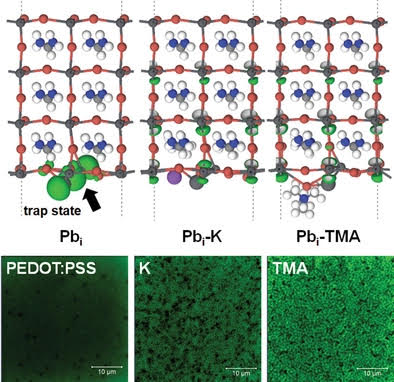
Thanh Luan Nguyen(Post-Doc. 제1저자)
Metal halide perovskites (MHPs) have attracted significant attention as light‐emitting materials owing to their high color purities and tunabilities. A key issue in perovskite light‐emitting diodes (PeLEDs) is the fabrication of an optimal charge transport layer (CTL), which has desirable energy levels for efficient charge injection while blocking opposite charges and enabling perovskite layer growth with reduced interfacial defects. Herein, two poly(fluorene‐phenylene)‐based anionic conjugated polyelectrolytes (CPEs) with different counterions (K+ and tetramethylammonium (TMA+)) are presented as multifunctional passivating and hole‐transporting layers (HTLs). The crystal growth of MHPs grown on different HTLs is investigated through X‐ray photoelectron spectroscopy, X‐ray diffraction, and density functional theory calculation. The CPE bearing the TMA+ counterions remarkably improves the growth of perovskites with suppressed interfacial defects, leading to significantly enhanced emission properties and device performance. The luminescent properties are further enhanced via aging and electrical stress application with effective rearrangement of the counterions on the interfacial defects in the perovskites. Finally, efficient formamidinium lead tribromide‐based quasi‐2D PeLEDs with an external quantum efficiency of 10.2% are fabricated. Using CPEs with varying counterions as a CTL can serve as an effective method for controlling the interfacial defects and improving perovskite‐based optoelectronic device properties.

https://onlinelibrary.wiley.com/doi/full/10.1002/adma.201900067
 Cytoplasmic Protein Imaging with Mid-Infrared Photothermal Mi...
Cytoplasmic Protein Imaging with Mid-Infrared Photothermal Mi...
 Covalently Linked Perylene Diimide–Polydiacetylene Nanofibers...
Covalently Linked Perylene Diimide–Polydiacetylene Nanofibers...

















